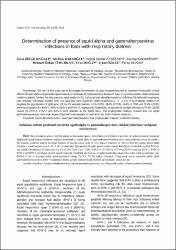| dc.contributor.author | Dağalp, Seval Bilge | |
| dc.contributor.author | Babaoğlu, Ali Rıza | |
| dc.contributor.author | Ataseven, Veysel Soydal | |
| dc.contributor.author | Karapınar, Zeynep | |
| dc.contributor.author | Timurkan, Mehmet Özkan | |
| dc.contributor.author | Doğan, Fırat | |
| dc.contributor.author | Özkul, Aykut | |
| dc.contributor.author | Alkan, Feray | |
| dc.date.accessioned | 2019-08-29T12:56:51Z | |
| dc.date.available | 2019-08-29T12:56:51Z | |
| dc.date.issued | 2018 | en_US |
| dc.identifier.issn | 1300-0861 | |
| dc.identifier.issn | 1308-2817 | |
| dc.identifier.uri | https://doi.org/10.1501/Vetfak_0000002828 | |
| dc.identifier.uri | https://hdl.handle.net/20.500.12462/6075 | |
| dc.description | Karapınar, Zeynep (Balikesir Author) | en_US |
| dc.description.abstract | The aim of this study was to investigate the presence of equid herpesviruses and to elucidate the possible mutual effects of equid alpha and gammaherpesviruses in an outbreak of respiratory tract disease in foals in a private pension stable (transient residency stable), Turkey. For this purpose, nasal swabs (n=21) and peripheral blood leukocytes (n=28) from 28 foals with respiratory tract diseases, and tissue samples from one dead foal were tested for equid herpesvirus-1, -4, -2 and -5 by multiplex nested PCR targeting the glycoprotein B (gB) gene. Of the 29 sampled animals, 3.4% (1/29), 58.6% (17/29), 58.6% (17/29) and 75.9% (22/29) were found positive for EHV-1, EHV-4, EHV-2 and EHV-5, respectively. Especially, a high ratio of multiple infections (75.9%; 22/29) caused by EHV-4, EHV-2 and EHV-5 were detected in the tested foals. The phylogenetic analysis showed that our equid gammaherpesviruses had a high degree of genetic heterogeneity, in contrast to our EHV-4 strains analyzed. | en_US |
| dc.description.abstract | Bu çalışmanın amacı, özel bir pansiyon harasında (geçici konaklama yeri) bulunan taylarda bir solunum sistemi hastalığı
salgınında equid herpesvirusların varlığını araştırmak ve equid alpha ve gammaherpesvirusların olası etkileşimlerini ortaya koymaktır.
Bu amaçla, solunum sistemi hastalığı bulgulu 28 taydan nazal swap (n=21), lökosit örnekleri (n=28) ve ölen bir taydan alınan doku
örnekleri, equid herpesvirus-1, -4, -2 ve -5 yönünden glikoprotein B (gB) genini tespit etmeyi hedefleyen multipleks nested PCR ile
test edildi. Örneklenen 29 hayvanın %3.4’ü (1/29), %58.6’sı (17/29), %58.6’sı (17/29) ve %75.9’u (22/29) sırasıyla EHV-1, EHV-4,
EHV-2 ve EHV-5 yönünden pozitif olarak bulundu. Özellikle söz konusu viruslar tarafından oluşturulan tekli enfeksiyonlardan çok,
EHV-1,-2 ve -5 arasında çoklu enfeksiyonların varlığı (%75.9; 22/29) dikkat çekiciydi. Filogenetik analiz sonuçları yerel equid
gammaherpesvirusların, EHV-4 suşlarının aksine genetik olarak büyük farklılık gösterdiğini ortaya koydu. | en_US |
| dc.language.iso | eng | en_US |
| dc.publisher | Ankara Univ Press | en_US |
| dc.relation.isversionof | 10.1501/Vetfak_0000002828 | en_US |
| dc.rights | info:eu-repo/semantics/openAccess | en_US |
| dc.subject | Equid Alphaherpesvirus | en_US |
| dc.subject | Equid Gammaherpesvirus | en_US |
| dc.subject | Foal | en_US |
| dc.subject | Phylogenetic Analysis | en_US |
| dc.subject | Respiratory Disease | en_US |
| dc.subject | Tay | en_US |
| dc.subject | Filogenetik Analiz | en_US |
| dc.subject | Solunum Sistemi Hastalığı | en_US |
| dc.title | Determination of presence of equid alpha and gammaherpesvirus infections in foals with respiratory distress | en_US |
| dc.title.alternative | Solunum sistemi problemli taylarda equid alpha ve gammaherpesvirus enfeksiyonlarının varlığının
belirlenmesi | en_US |
| dc.type | article | en_US |
| dc.relation.journal | Ankara Universitesi Veteriner Fakültesi Dergisi | en_US |
| dc.contributor.department | Veteriner Fakültesi | en_US |
| dc.contributor.authorID | 0000-0001-5008-9443 | en_US |
| dc.contributor.authorID | 0000-0002-2743-8948 | en_US |
| dc.identifier.volume | 65 | en_US |
| dc.identifier.issue | 1 | en_US |
| dc.identifier.startpage | 63 | en_US |
| dc.identifier.endpage | 68 | en_US |
| dc.relation.publicationcategory | Makale - Uluslararası Hakemli Dergi - Kurum Öğretim Elemanı | en_US |


















